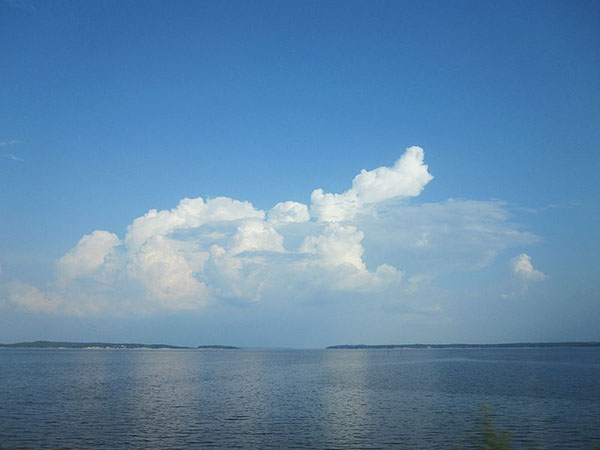Toledo Bend
Toledo Bend Lake, the largest man-made reservoir in the South, is located on the Sabine River between Louisiana and Texas.

Wikimedia Commons.
Toledo Bend.
Toledo Bend, the largest manmade reservoir in the South, is located on the Sabine River along the border of Louisiana and Texas. With an average surface area of about 180,000 acres, the lake provides a municipal and industrial water source, generates hydroelectric power, and fuels the local rural economy mainly through sportfishing-related tourism.
Toledo Bend is the fifth-largest constructed reservoir in the United States, and the lake’s watershed comprises 7,178 square miles. Lands acquired for the reservoir included 101,600 acres in Sabine and DeSoto Parishes in Louisiana, and 80,000 acres in Sabine, Shelby, Panola, and Newton Counties in Texas. The lake stretches upstream from the dam site above Burkeville, Texas, for sixty-five miles to near Logansport, Louisiana. The shoreline is approximately 1,200 miles long.
The total cost of the project approached $70 million and was shared equally by Texas and Louisiana. It is the only large hydroelectric power project in the United States constructed without major federal financing.
History
The idea of a giant reservoir on the Sabine River surfaced in a US Army Corps of Engineers feasibility report in the late 1930s. World War II soon intervened and delayed headway until the creation of the Sabine River Authority of Texas in 1949; Louisiana established a similar group in 1950. Both units were tasked with water management of the Sabine River for the mutual benefit of each state. Along with relevant federal agencies, the groups developed a working compact that was ratified by the Texas legislature in 1953 and the Louisiana legislature the following year. A 1955 memorandum of understanding stipulated that the states would equally finance aspects of the reservoir project. When numerous feasibility studies indicated that the project was practical, Louisiana and Texas each approved $30 million bond measures in 1959. The sale of hydroelectric power was to be the sole source of bond repayment.
The Toledo Bend project was not without controversy. Although various business leaders and politicians supported it, many local residents opposed the plans on the grounds that their private property would be expropriated, homes and livelihoods lost, and cemeteries disturbed. The Choctaw-Apache Indian tribe claimed it was being forced from thousands of acres of ancestral lands. From a cultural resource perspective, hundreds of archaeological sites would be flooded and the Sabine Breastworks, a Civil War feature, inundated. From an ecological perspective, thousands of acres of forest—including 35,000 acres in Texas’s Sabine National Forest—would be permanently lost. In the end, however, the lake developers prevailed.
On October 5, 1961, Gov. Jimmie Davis of Louisiana and Gov. Price Daniel of Texas presided over a groundbreaking ceremony at the dam site. Land acquisition began in May 1963. Construction of the dam, spillway, and power station started in April 1964. Commercial timber was removed from the lake basin, followed by land-clearing operations. Utilities, roads, and some buildings were relocated. Several cemeteries were moved to higher ground. The last section of the earthen dam was closed on October 3, 1966, and the lake began to fill. By early 1969, the power plant began operations. An estimated one thousand people attended the dedication ceremony to commemorate the completion of the project on October 11, 1969. The masters of ceremonies for the event were Gov. John McKeithen of Louisiana and Gov. Preston Smith of Texas.
Since the reservoir was constructed, Toledo Bend has become one of the most popular fishing destinations in Louisiana. Bass fishing is the most common activity on the lake. Dozens of fishing tournaments are held there each year, and the lake is a regular stop on the Bassmaster Elite Series professional fishing tournament tour. An infrastructure has developed in the region to support such tourism. Private marinas, motels, restaurants, and campgrounds as well as state parks and recreation areas are scattered around the lake.
